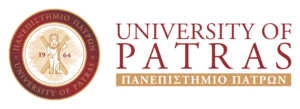The Corinth Rift Laboratory (CRL) is an international NFO, with field actions ongoing for more than 30 years by many European partners. The first permanent station was installed in 2000 and, since then, almost 80 permanent sensors - including seismometers, accelerometers, GNSS, strainmeters, tilt-meters, and tide gauges - have been operational, broadcasting real-time data.
The western part of the Gulf of Corinth is deforming at a rate that reaches 15 mm/yr, being among the fastest- opening active continental rifts worldwide. It is bounded on both sides by seismogenic normal faults, onshore and offshore. The southern coast is flanked by major north-dipping active faults, while along the northern coast, there exist steeper, south-dipping antithetic faults. Seismic activity within the Corinth Rift is characterized by the frequent occurrence of earthquake swarms, likely triggered by the propagation of pressurized fluids and pore-pressure diffusion through the fault network. The most recent seismic crisis took place in the western part of the rift between December 2020 and February 2021, activating different faults. It involved intense swarm activity near the northern coast and culminated with an Mw=5.3 earthquake towards the west. This seismic crisis prompted the scientific community to focus on the NFO and collaborate for the publication of several studies.

The area has one of the highest seismicity rates in the Euro-Mediterranean region, with, on average, one Mw≥6 earthquake per decade. Over the past 800 years, 26 events of magnitude Mw≥6 have occurred. Seven of them took place during the 20th century (1909, 1938, 1965, 1970, 1992, 1993, and 1995). In 2008, an Mw = 6.4 earthquake occurred outside CRL, but in a rupture zone connected with the Corinth Rift. The study of its characteristics was crucial for deciphering the deformation processes at the western termination of the rift.
In addition to monitoring and research activities, every September, an experiential workshop, the CRL School, is held for five days, with the participation of MSc and PhD students and secondary school teachers on topics of CRL-related research. CRL School has improved public outreach and increased visibility in the scientific community. National and European projects, which primarily addressed in-depth research issues but also contributed to the densification of the network, have been: SING, CORSEIS, 3F Corinth, DG-LAB, ASSEM, GDR-Corinth, AEGIS, 3Haz-Corinth (FP6-SUSTDE), CatTel@CRL, Jouvence CRL, SISCOR, CzechGeo/EPOS, and REAKT.
Intermittently, the Hellenic Plate Observing System (HELPOS) project, which focused on the whole Greek territory, partially funded a component of infrastructure maintenance and upgrade. HELPOS, funded by the National Strategic Reference Framework of Greece and the EU, enabled sustainable long-term Earth science and earthquake engineering research strategies, along with an effective coordinated monitoring facility, inspired by and contributing to EPOS.
The Alto Tiberina Near Fault Observatory (TABOO) is a permanent monitoring infrastructure managed by the Istituto Nazionale di Geofisica e Vulcanologia (INGV). The Alto Tiberina fault (ATF) is located along a 3 mm/yr extending sector of the Northern Apennines (Central Italy), is a 60-km-long, very low-angle normal fault (mean dip 20°) and is the target of TABOO.
TABOO is a state-of-the-art dense network with a mean inter-distance of about 5 km between multidisciplinary sensors, deployed both at the surface and within shallow boreholes (<250m). All sensors record and transmit in real-time via dedicated Wi-Fi technology; then data is stored in standard formats on open-access thematic portals and distributed via web services. While seismic data from TABOO reveal the release of microseismicity, at a consistently high rate on the ATF fault plane, no large historical earthquake can be unambiguously associated with the activation of the whole ATF. At the same time, steep gradient in crustal velocities, measured by GNSS, and transient surface motion, lasting for few months and coinciding with seismic swarms, support the hypothesis that portions of the ATF are creeping aseismically. Recent studies document that any given patch of a fault can creep, nucleate slow earthquakes, and also host large earthquakes (e.g., the Iquique earthquake). Why a fault patch would switch from one mode of slip to another, runs contrary to the standard theory. These observations are forcing a revolution in our way of thinking about how faults accommodate slip.
TABOO is currently collecting unique data, including a new borehole strainmeter array, needed to address the interaction between creep, slow and regular earthquakes, with important implications for seismic hazard and risk assessment globally.
The IRPINIA NFO is an EPOS infrastructure located in the Campania-Lucania Region (Southern Italy), covering the seismogenic areas that generated major earthquakes of the last centuries, including the 23 November 1980, Ms = 6.9 event. The goal of the observatory is to monitor the seismicity evolution, characterize the microseismicity and understand the underlying chemical and physical processes occurring along the fault systems that can potentially generate large earthquakes in the area.
The Irpinia NFO is currently composed of the ISNet - Irpinia Seismic Network, with associated products and services. ISNet is a dense, high-dynamic range, local seismic network of 32 stations, covering an area of about 100 × 70 km 2 and deployed within two imaginary concentric ellipses, with the major axis parallel to the Apennine chain. The mean distance between stations in the outer ellipse is about 20 km, while the distance between the two ellipses is about 10 km. The average inter-station distance within the inner ellipse is less than 10 km. All stations are equipped with a strong-motion accelerometer and a weak motion sensor, the latter being a short-period, a broadband velocimeter, or an accelerometer with lower full-scale. Stations of ISNet provide real- time data with a controlled delay at the ISNet control center, enabling the network to be the backbone infrastructure for testing and application of earthquake early warning systems and for near real-time computation of regional ground-shaking maps.
The VALAIS NFO is a particularly dense multidisciplinary component of the monitoring infrastructure in Switzerland, operated by the Swiss Seismological Service at ETH Zurich. Although damaging earthquakes are rare in Switzerland when compared to more seismically active regions, such events have occurred and will continue to do so. Over the past 700 years, a total of 28 events of magnitude Mw≥5.5 are known, twelve of which caused severe damage (Intensity of VIII or higher). Valais is the area of greatest seismic hazard in Switzerland and experiences a magnitude 6 or larger event every 100 years (1524, 1584, 1685, 1755, 1855, 1946), with the last magnitude 6.1 earthquake in 1946 close to Sion and Sierre. This area and in particular the region of Visp holds special interest: on average, the Visp region has been struck by damaging earthquakes every 40 years, with the last in 1960 reaching a macroseismic intensity of VIII. The Visp event of 1855 has been the largest in Switzerland for the last 300 years.
Besides its seismic activity, the test area in the Valais is characterized by several factors adding to the total hazard level: rough topography, unstable and steep slopes, deep sediment-filled valleys, and wide glacier- and snow-covered areas. The area has experienced great damage from earthquake ground motion and secondary phenomena, such as liquefaction in the Rhone plain, landslide reactivation, and extended rock fall. Due to river regulations and engineering progress in the last two centuries, settlements and industries have expanded into seismically vulnerable areas; during the last century, many villages extended into the Rhone plain and near hazardous slopes in the valleys.
The particular densification of the seismic monitoring in the Valais, as well as the introduction of complementary multidisciplinary instrumentation, including those with the potential to provide precursory information, began during the COGEAR project and continues today. The network is dominated by a dense backbone broadband network and strong motion stations, in particular, located along the length of the River Rhone. GNSS and magnetotelluric sensors complement this network. The Valais NFO is located within the National Swiss Seismic Network, consisting of over 300 permanent seismic stations, about 150 of which are strong motion only, while the majority of others include both broadband and strong motion. A deep rock physics laboratory at Bedretto lies on the Eastern edge of the Valais and comprises a dense seismic network, a DAS cable as well as many other sensors. All infrastructure across Switzerland at all scales is available for testing hardware and software developed in TRANSFORM2, and EEW testing will be developed at the national scale.
The VRANCEA NFO is an innovative research infrastructure providing high-quality multidisciplinary data aimed at improving the understanding of multi-scale, physical/chemical processes responsible for earthquakes and faulting. The data generated by VRANCEA is collected, archived, and processed in order to enable open science domain and cross-domain science, coherently with the long-term vision of EPOS.
The Vrancea NFO is a multidisciplinary network whose backbone is composed of seismic stations together with infrasound and seismic arrays, a GPS network (10 Hz SPS), a Radon monitoring system, meteorological stations, electromagnetic stations, and atmospheric ionization monitoring systems. The seismic stations are equipped with both short-period/broadband and strong motion sensors, deployed on the surface or in shallow boreholes. Vrancea area, located within the bend region of the Carpathian orogen, is one of the most active seismic zones with intermediate-depth earthquakes in Europe. Vrancea seismic zone consists of both intermediate and crustal depth earthquakes. The crustal events are moderate (Mw ≤ 5.5) while the intermediate-depth ones often exceed Mw = 7.0 and are felt in a wide area. The strongest earthquakes in Vrancea occur in a limited volume, at focal depths ranging between 70 and 180 km. The earthquakes of 10 November 1940 (Mw 7.7, 150 km depth) and 4 March 1977 (Mw 7.4, 94 km depth) affected half of Romania (especially the extra-Carpathian region) and neighboring countries such as Bulgaria, Moldova, Serbia, and Ukraine. Specifically, the 1940 earthquake caused significant building damage and at least 593 fatalities in Romania (out of which 140 were in Bucharest, the Romanian capital city) and about 78 fatalities in Moldova.
The National Institute for Earth Physics (NIEP) is operating in Vrancea NFO area a fully operational Earthquake Early Warning System (EEWS) designed for strong intermediate events. The seismic infrastructure is tailored (spatially and technically) to detect and locate intermediate-depth earthquakes. The EEWS main target site is the capital city, Bucharest. Until now, the existing EEWS has issued more than 50 successful alerts, all with a leading time larger than 25 seconds, to a group of legal authorities (~450) from emergency response agencies through an SMS gateway, to 16 dedicated EEWS receivers located in Romania and Bulgaria at various governmental agencies, to a nuclear research institute in Bucharest or to Vidraru Dam. Also, the alert is sent to nuclear power plants “Kozloduy” at the town of Cernavoda and in Bulgaria. During the last years, NIEP has been freely testing and benchmarking the communication performance to users through social platforms.
The MARMARA NFO has been established to monitor a “seismic gap” that exists in a ~100-150-km-long segment of the North Anatolian Fault Zone (NAFZ) below the Sea of Marmara, which connects the Ganos (1912, Mw7.3) and Izmit (1999, Mw 7.4) ruptures. Estimates from past earthquakes, interseismic behavior, and dynamic rupture models indicate that the Central Marmara Segment is capable of generating a single large earthquake with a magnitude equal to or greater than 7.1, or a number of smaller, moderate events with a normal faulting regime. The estimated 30-year probability for an event of M≥7 below the Sea of Marmara is 35-70%. Considering that the last possible earthquake that might have ruptured a section of the Marmara seismic gap was probably in 1766, the region poses one of the highest seismic hazards in Europe.
There are many active networks to monitor heterogeneous interseismic loading, which have creeping/locked segments (Central Marmara), with multi-parameter datasets (seismology, GNSS/SAR, sea-level stations, strainmeters, etc.). The MARMARA NFO has been built up by the consortium of the European Commission funded MarSite project (2012-2016), as one of the EU-level Supersites under the threat of multiple geological hazards, which could cause great loss of human population and critical facilities. All activities in Marmara were re-organized under the EPOS umbrella and continue as part of the European NFO federated structure, with its historic data archive and scientific background. The main backbone has been built by local Universities (e.g. Boğaziçi University-KOERI, Istanbul University) and governmental organizations (AFAD, TUBITAK, General Directorate of Mapping). At the same time, many international efforts have been initiated to study the earthquake hazard. For example, to monitor the microseismic activity in the NAFZ, offshore of Istanbul, below the Çinarcik Basin (ÇB), a permanent seismic array (PIRES) was installed on the Prince Islands in 2006, at a very close proximity to the main fault. It is a permanent network jointly operated by the German Research Centre for Geosciences (GFZ) in Potsdam, Germany, and BU-KOERI, aiding the analysis of the spatiotemporal character of microseismicity.
The Northeastern Italy Thrust Faults Observatory (NITRO) NFO performs multidisciplinary activities aimed at studying the Alpine system around the epicenter of the damaging M6.4 earthquake that occurred at the Friuli region in 1976. This proposed NFO focuses on a thrust fault system, therefore complementing, in terms of dominant fault mechanism, the other already existing Italian NFOs and the NFO expected to be formally established soon in southeastern Slovenia (KARST).
KARST NFO is expected to be formally established soon in southeastern Slovenia. It is located a few tens of kilometers of distance from NITRO but on a very different tectonic setting, the northwestern Dinaric one, a region still undergoing active tectonic deformations (<5mm/yr), with dominant transpressive and strike-slip mechanisms. Hence, the NITRO and the Slovenian observer NFO have the potential to monitor the interaction between the Alpine and Dinaric systems, having a key role in the seismotectonic and the hazard of this European region.
EGERI NFO is located in the area of West Bohemia/Vogtland, at the western shoulder of the Eger Rift. Earthquake swarms, accompanied by a long-term multifold increase mantle CO 2 degassing and Quaternary volcanism occur.
Subscribe our newsletter

















